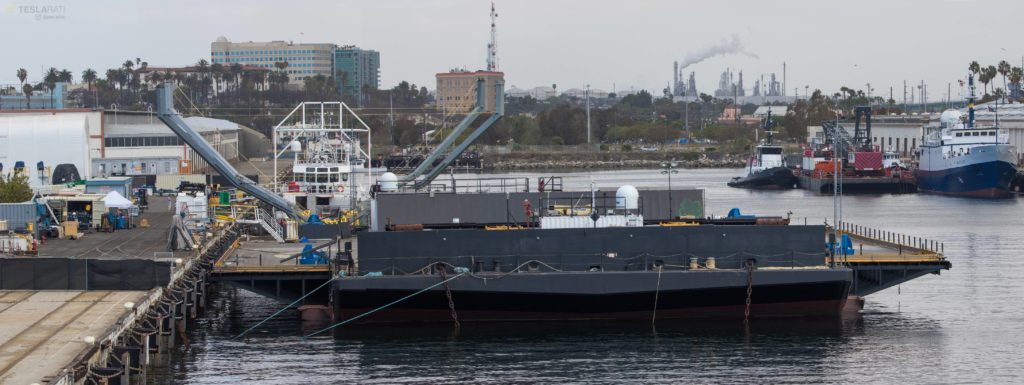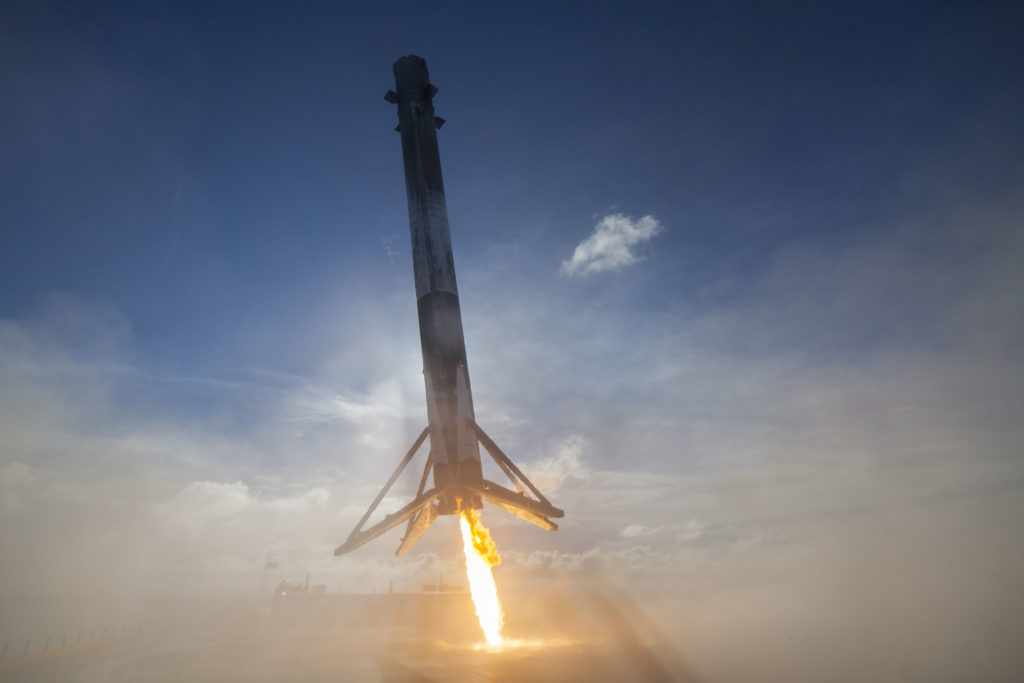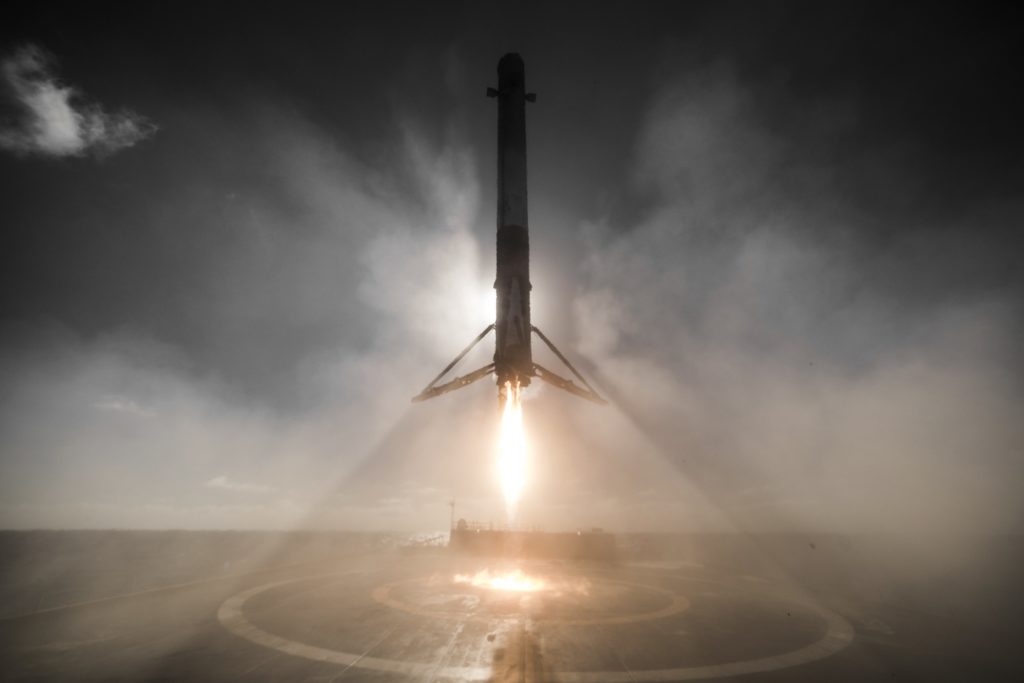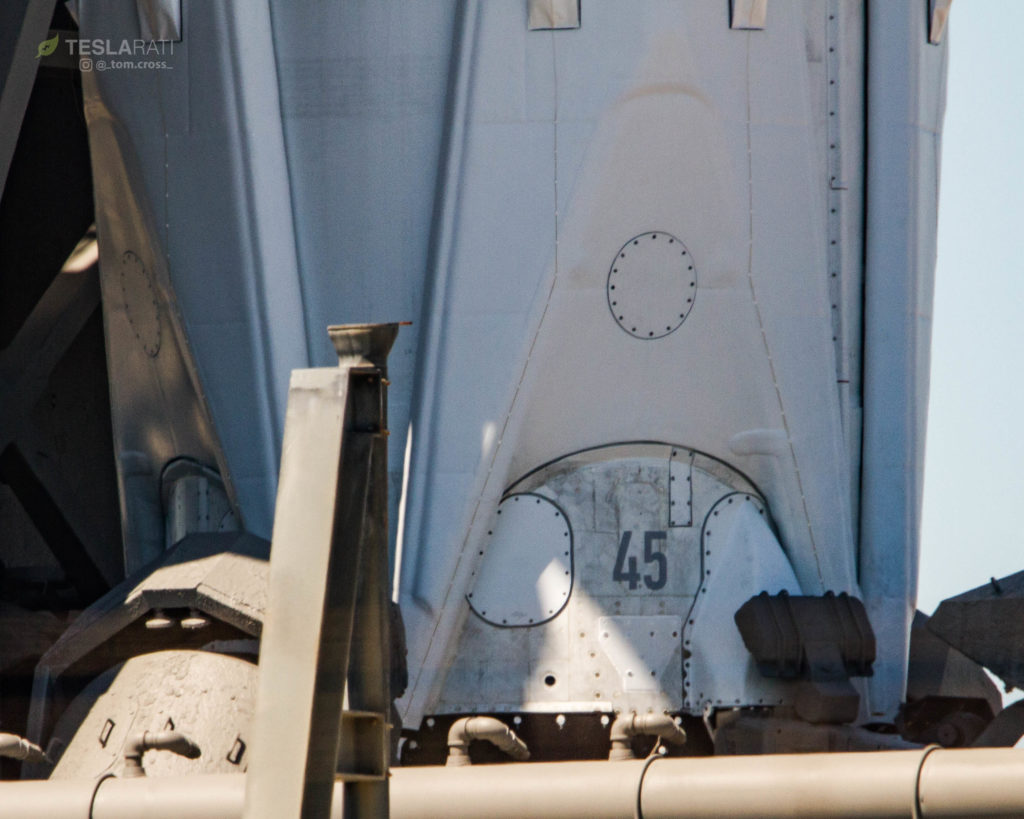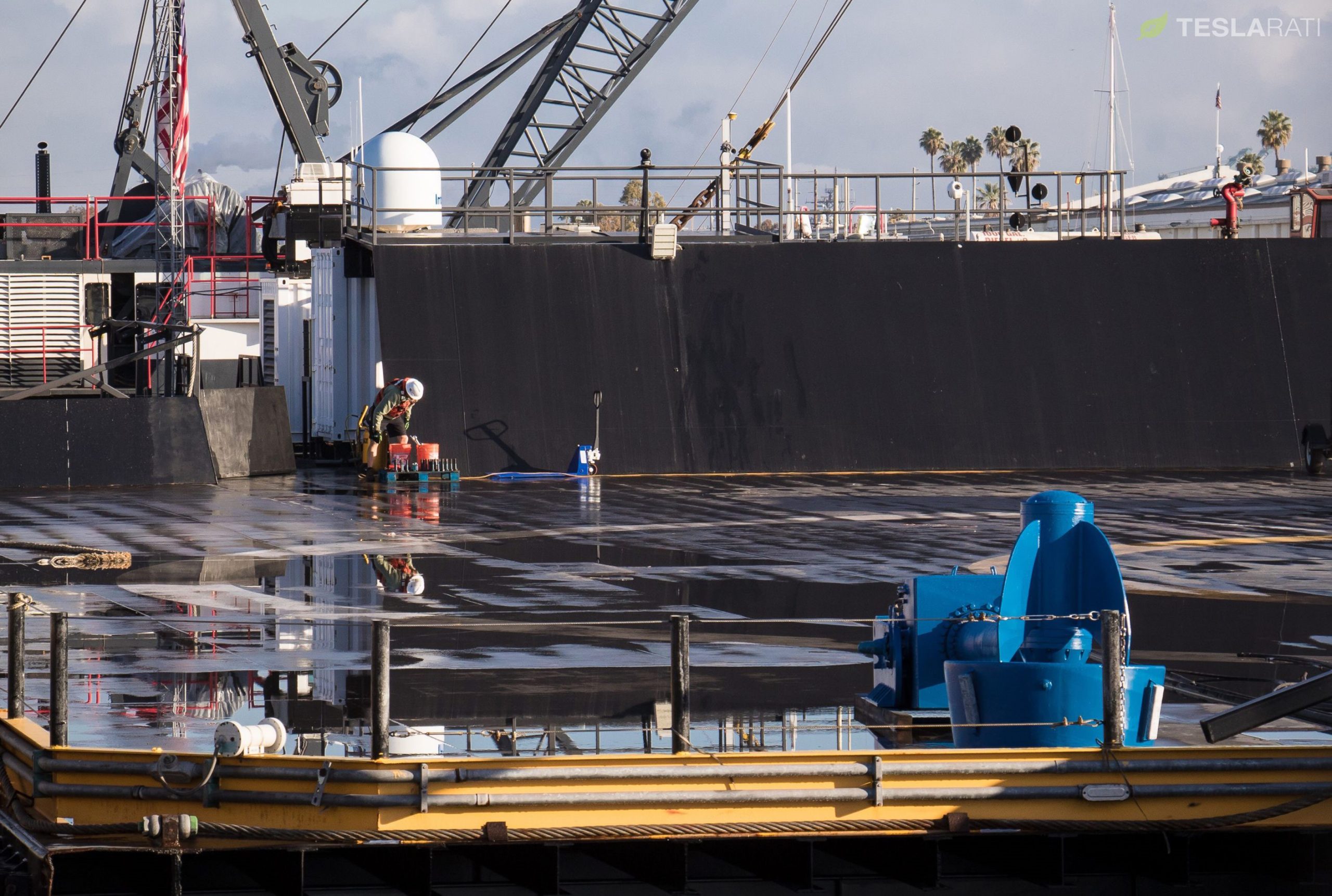
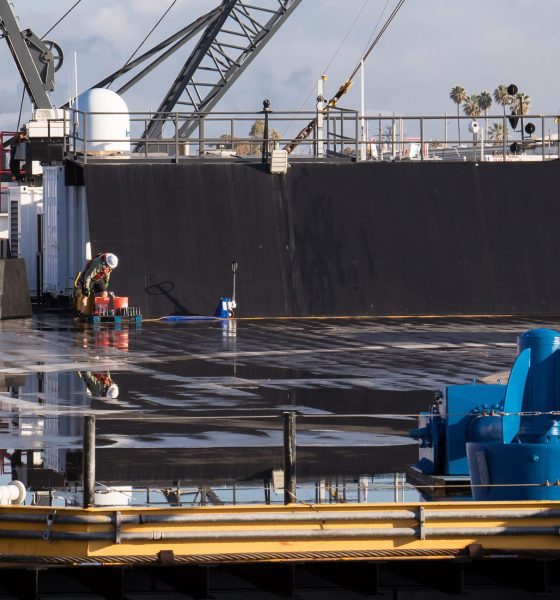
News
SpaceX’s drone ships near return-to-action with Block 5 Falcon 9 landings
Teslarati photographer Pauline Acalin’s recent trips to drone ship Just Read The Instructions’ berth in Port of San Pedro shows that SpaceX technicians are nearly done preparing the hibernating vessel for a return to Falcon 9 rocket recoveries in the Pacific Ocean, a ten-month drought likely to end for good on July 20th.
Although it’s hard to believe, SpaceX’s West Coast autonomous spaceport drone ship (ASDS) has been effectively marooned at its Port of Los Angeles berth for more than nine full months, with the vessel’s last recovery occurring just after the October 9 launch of ten Iridium NEXT satellites, the fourth of five SpaceX Vandenberg launches in 2017 (and the fourth of four West Coast booster landings).
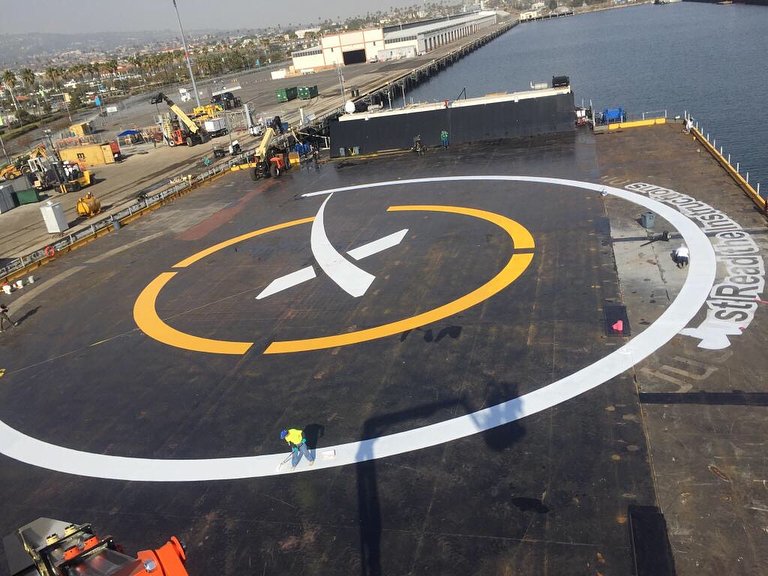
SpaceX’s West coast drone ship Just Read The Instructions getting some much needed fresh paint in 2017. (Instagram, anonymous)
Three months after that October mission and booster recovery, SpaceX expended their next California launch and marked the beginning of a streak of eight missions where flight-proven Block 3 and 4 boosters could have been recovered but no attempts were made. While intermixed with the spectacle of Falcon Heavy’s dual side booster landings at LZ-1, the debut launch and recovery of Falcon 9 Block 5, and two other Block 4 booster recoveries, the majority of SpaceX’s launches since December 2017 have been treated as expendable – put simply, the company decided that recovering and refurbishing twice-flown boosters of older Falcon 9 blocks was not worth the effort and expense.
Instead, those well-worn boosters were expended in the Pacific and Atlantic Oceans after partially supporting a series of experimental tests designed to gather additional data on the recovery envelope of SpaceX’s partially reusable rockets. The rationale makes sense – SpaceX fundamentally sacrificed some of its older, less-reusable Falcon 9 boosters for the sake of knowledge that may allow their highly reusable Falcon 9 Block 5 predecessors a better chance of successfully landing even after exceptionally fast, hot, and high-energy recoveries, a necessity if the upgraded rockets are to be reused 10 to 100 times, as is the goal.
Although Just Read The Instructions spent several months without a full complement of maneuvering thrusters, thanks in part to efforts to keep its besieged East coast sister Of Course I Still Love You operational, photographer Pauline Acalin’s photos over the last several months show that the vessel now has four full thrusters installed and ready to bring it back into rocket recovery action in the Pacific Ocean.
- SpaceX’s drone ship Just Read The Instructions and fairing catcher Mr Steven at their Port of San Pedro berths, May 2018. Note the four bright blue thrusters visible aboard JRTI, three installed and one on deck. (Pauline Acalin)
- The aggressive Atlantic Ocean landing of Thaicom-8’s Falcon 9 first stage. (SpaceX)
- Iridium-1’s successful and scenic landing on Pacific drone ship JRTI, January 2017. This could be an increasingly rare occurrence in the Pacific, thanks to SpaceX’s new land-based landing zone. (SpaceX)
Still, the abrupt return to expendable rocket launches after a year – 2017 – filled to the brim with 18 of 18 successful launches and 14 of 14 successful landings led to a decidedly fascinating vein of disapproval in the SpaceX enthusiast and broader spaceflight fan communities – people had grown accustomed to the adrenaline-soaked thrill of routine Falcon 9 rocket landings. Some expressed worries that regularly and intentionally expending large hunks of metal in the ocean could harm their ecosystems and was tantamount to littering. None the wiser, every other launch provider in the world continues to expend all of their rocket boosters without any attempts at recovery like the nearly all non-Shuttle rocket launches in the past six decades, and their tepidly reusable next-generation rockets are unlikely to even begin attempting hardware recovery until the mid-2020s at the earliest.
Frankly, SpaceX’s abrupt successes with orbital-class rocket recovery struck a chord with observers, demonstrating just how intuitive attempting to recover expensive rocket hardware really is, while also bringing into clear focus the actual insanity of failing to try and of the seemingly ad-hoc rationalization of expendable rocketry. Thankfully, we still have SpaceX, and the company’s spate of rocket booster sacrifices is likely just one expendable launch away from coming to an effective end for the indefinite future, with that particular launch – CRS-15 – scheduled less than two weeks from now, on June 29th.
- B1045, tasked with launching NASA’s TESS exoplanet observatory, roughly 24 hours before liftoff. (Tom Cross)
- After launching in April 2018, B1045 landed on OCISLY and is being refurbished for a second launch in just 5 days, on June 29. (Tom Cross)
After CRS-15, which will probably see its twice-flown Block 4 booster expended in the Atlantic, a combination of Block 5 Falcon 9s and Heavies will theoretically bring to an end the practice of expending orbital rocket boosters, at least on SpaceX’s watch. Considering that the upgraded boosters have been designed and built to launch as many as ten times with minimal refurbishment and potentially 100+ times with regular maintenance, the opportunity cost of an expended Block 5 rocket booster is so high that it is difficult to imagine SpaceX will be easily swayed to expend one until it’s flown at least several times prior.
We here at Teslarati eagerly await the imminent demise of expendable rockets, set to begin in earnest – at least for SpaceX – around July 19th and 20th with two Falcon 9 Block 5 launches on two coasts, one with Telstar 19V (Florida) and the other with Iridium-7 (California).
Follow us for live updates, peeks behind the scenes, and photos from Teslarati’s East and West coast photographers.
Teslarati – Instagram – Twitter
Tom Cross – Twitter
Pauline Acalin – Twitter
Eric Ralph – Twitter

Elon Musk
Elon Musk and Tesla AI Director share insights after empty driver seat Robotaxi rides
The executives’ unoccupied tests hint at the rapid progress of Tesla’s unsupervised Robotaxi efforts.

Tesla CEO Elon Musk and AI Director Ashok Elluswamy celebrated Christmas Eve by sharing personal experiences with Robotaxi vehicles that had no safety monitor or occupant in the driver’s seat. Musk described the system’s “perfect driving” around Austin, while Elluswamy posted video from the back seat, calling it “an amazing experience.”
The executives’ unoccupied tests hint at the rapid progress of Tesla’s unsupervised Robotaxi efforts.
Elon and Ashok’s firsthand Robotaxi insights
Prior to Musk and the Tesla AI Director’s posts, sightings of unmanned Teslas navigating public roads were widely shared on social media. One such vehicle was spotted in Austin, Texas, which Elon Musk acknowleged by stating that “Testing is underway with no occupants in the car.”
Based on his Christmas Eve post, Musk seemed to have tested an unmanned Tesla himself. “A Tesla with no safety monitor in the car and me sitting in the passenger seat took me all around Austin on Sunday with perfect driving,” Musk wrote in his post.
Elluswamy responded with a 2-minute video showing himself in the rear of an unmanned Tesla. The video featured the vehicle’s empty front seats, as well as its smooth handling through real-world traffic. He captioned his video with the words, “It’s an amazing experience!”
Towards Unsupervised operations
During an xAI Hackathon earlier this month, Elon Musk mentioned that Tesla owed be removing Safety Monitors from its Robotaxis in Austin in just three weeks. “Unsupervised is pretty much solved at this point. So there will be Tesla Robotaxis operating in Austin with no one in them. Not even anyone in the passenger seat in about three weeks,” he said. Musk echoed similar estimates at the 2025 Annual Shareholder Meeting and the Q3 2025 earnings call.
Considering the insights that were posted Musk and Elluswamy, it does appear that Tesla is working hard towards operating its Robotaxis with no safety monitors. This is quite impressive considering that the service was launched just earlier this year.
Elon Musk
Starlink passes 9 million active customers just weeks after hitting 8 million
The milestone highlights the accelerating growth of Starlink, which has now been adding over 20,000 new users per day.

SpaceX’s Starlink satellite internet service has continued its rapid global expansion, surpassing 9 million active customers just weeks after crossing the 8 million mark.
The milestone highlights the accelerating growth of Starlink, which has now been adding over 20,000 new users per day.
9 million customers
In a post on X, SpaceX stated that Starlink now serves over 9 million active users across 155 countries, territories, and markets. The company reached 8 million customers in early November, meaning it added roughly 1 million subscribers in under seven weeks, or about 21,275 new users on average per day.
“Starlink is connecting more than 9M active customers with high-speed internet across 155 countries, territories, and many other markets,” Starlink wrote in a post on its official X account. SpaceX President Gwynne Shotwell also celebrated the milestone on X. “A huge thank you to all of our customers and congrats to the Starlink team for such an incredible product,” she wrote.
That growth rate reflects both rising demand for broadband in underserved regions and Starlink’s expanding satellite constellation, which now includes more than 9,000 low-Earth-orbit satellites designed to deliver high-speed, low-latency internet worldwide.
Starlink’s momentum
Starlink’s momentum has been building up. SpaceX reported 4.6 million Starlink customers in December 2024, followed by 7 million by August 2025, and 8 million customers in November. Independent data also suggests Starlink usage is rising sharply, with Cloudflare reporting that global web traffic from Starlink users more than doubled in 2025, as noted in an Insider report.
Starlink’s momentum is increasingly tied to SpaceX’s broader financial outlook. Elon Musk has said the satellite network is “by far” the company’s largest revenue driver, and reports suggest SpaceX may be positioning itself for an initial public offering as soon as next year, with valuations estimated as high as $1.5 trillion. Musk has also suggested in the past that Starlink could have its own IPO in the future.
News
NVIDIA Director of Robotics: Tesla FSD v14 is the first AI to pass the “Physical Turing Test”
After testing FSD v14, Fan stated that his experience with FSD felt magical at first, but it soon started to feel like a routine.

NVIDIA Director of Robotics Jim Fan has praised Tesla’s Full Self-Driving (Supervised) v14 as the first AI to pass what he described as a “Physical Turing Test.”
After testing FSD v14, Fan stated that his experience with FSD felt magical at first, but it soon started to feel like a routine. And just like smartphones today, removing it now would “actively hurt.”
Jim Fan’s hands-on FSD v14 impressions
Fan, a leading researcher in embodied AI who is currently solving Physical AI at NVIDIA and spearheading the company’s Project GR00T initiative, noted that he actually was late to the Tesla game. He was, however, one of the first to try out FSD v14.
“I was very late to own a Tesla but among the earliest to try out FSD v14. It’s perhaps the first time I experience an AI that passes the Physical Turing Test: after a long day at work, you press a button, lay back, and couldn’t tell if a neural net or a human drove you home,” Fan wrote in a post on X.
Fan added: “Despite knowing exactly how robot learning works, I still find it magical watching the steering wheel turn by itself. First it feels surreal, next it becomes routine. Then, like the smartphone, taking it away actively hurts. This is how humanity gets rewired and glued to god-like technologies.”
The Physical Turing Test
The original Turing Test was conceived by Alan Turing in 1950, and it was aimed at determining if a machine could exhibit behavior that is equivalent to or indistinguishable from a human. By focusing on text-based conversations, the original Turing Test set a high bar for natural language processing and machine learning.
This test has been passed by today’s large language models. However, the capability to converse in a humanlike manner is a completely different challenge from performing real-world problem-solving or physical interactions. Thus, Fan introduced the Physical Turing Test, which challenges AI systems to demonstrate intelligence through physical actions.
Based on Fan’s comments, Tesla has demonstrated these intelligent physical actions with FSD v14. Elon Musk agreed with the NVIDIA executive, stating in a post on X that with FSD v14, “you can sense the sentience maturing.” Musk also praised Tesla AI, calling it the best “real-world AI” today.
